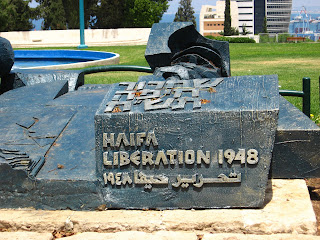

Biddu is a village in between Ramallah and Jerusalem - a distance that probably used to take 30 minutes to drive, is now not possible except through a matrix of closed roads, new roads, and checkpoints.
We drove around these roads with Mohammad who is a taxi driver and lives in Biddu so he knows the roads all too well. On the road to Biddu we passed through one checkpoint where the 18yr old IDF solidiers asked why we were in the car with Mohammad - to which he replied we were his friends and going for lunch at his house. The nerve of 18year old Israelis who sit at checkpoints and questions men twice their age about driving along their own goddamn road. I could go on and on about soldiers at checkpoints who also sit there and text message their girlfriends or boyfriends while holding an entire line of cars up. Total arrogance.
Many of the roads around Biddu are closed off - literally piles of dirt and cement are put in the middle of the road to create a barrier - then a watch tower further down. One of the main roads has been taken over as a settler-only highway, and a new road has been created for the Palestinians that cuts directly through the best agricultural land then turns in to a cave-like tunnel that goes UNDER the settler highway (that used to be a Palestinian road). The wall runs along side this highway and then weaves through the land up towards Biddu. In this area it is partially a full wall, and then partially an electronic fence covered in barbed wire and a military road along side it - oh yes and watchtowers and patrols.
In entering the village of Biddu Mohammad shows us the field where his cousin was shot by a sniper while working in the field - Mohammad was the only other person there and his cousin died in his arms after he tried to carry him back to the village.
Then we are shown different sections of the wall - including where his families land has been confiscated and only 4 olive trees remain. Further up is Sabri's house. Sabri's house is located on the edge of the village and directly next to where settlers chose to build Har Adar settlement. When the construction on the wall began the Israelis attempted to bulldoze Sabri's house - but the community resisted. Then they tried to buy him out - but he refused. So then they built the wall AROUND his house - literally enclosing his small house in to a cage on 3 sides, and a long gate on the front. It is a 10metre high fence complete with razor wire, a gate for the soldiers to enter, spotlights, cameras, and a bridge over top for soldiers and settlers to cross. All of his land was confiscated, there is only enough room for a few tomato plants between the space of his house and the fence - plants which Sabri clearly tends to with total care.
On the other side of the fence is the upscale community of Har Adar. Lush green lawns, full-size new houses, basketball courts, families having bbq's. All looking over Sabri's cage. Apparently they are able to water their lawns and not notice the massive cage directly in front of them..or they don't give a damn. Probably the latter, as Sabri talks about him and his grandchildren being constantly harassed by settlers - trying to intimidate him in to leaving. Somehow the Israelis have found 75 year old Sabri who is half blind and deaf sitting on his front steps stuck in a cage to be a severe security threat. God forbid that he should one day try to leave his cage - maybe even step on to the settlement - maybe reclaim his stolen land?! It would certainly be more than his right to do so. But Sabri is resisting in his way - he has stayed and has refused to let them have the last word. He waits for when he can take back his land. Biddu has had a strong history of resisting the Wall. I am told they have 5 young martyrs, hundreds injured and many many in prison. The main demonstrations were held in the year of 2004 with not very much press coverage or international support. It has seen a lot of violence for a village of only 6 500 people.
Just outside of the village are the best known grape fields in the region as residents of Biddu will proclaim proudly. I wish I could have taken a picture of the grape fields - it was like a small paradise on its own - never mind in comparison to the barbed wire fences.






































